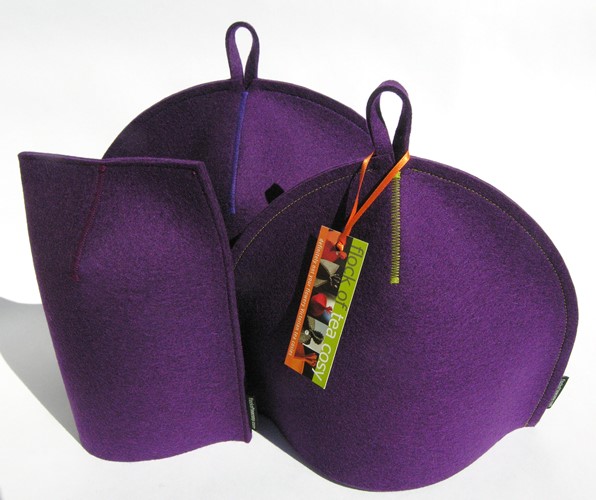
by Flock of Tea Cosy | Flock's Diary of modern wool felt teaware
It was love at first sight for me, because of its density and thickness and its vibrant colours, but a number of the reasons to love this beautiful, non-woven wool fabric are invisible.
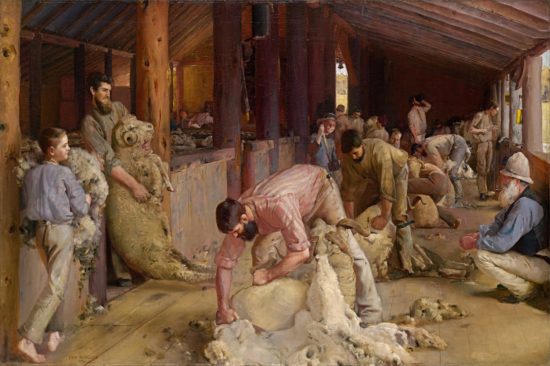
- It’s a renewable resource. Sheep continually grow their wonderful woolly coats which are sheared each spring.
- It’s naturally fire resistant and is self extinguishing. If you hold a match to genuine, 100% wool felt it will start to burn — but if you take the lit match away the fire on the felt will smoulder and go out on its own.
- It has high thermal insulating properties and this is what makes wool felt brilliant for a tea cosy. (It is also extremely sound absorbing but that doesn’t generally matter for tea cosies.)
- It’s naturally water repellent — spilt tea, for instance, will first bead on the surface of wool felt giving one the opportunity to quickly blot it up.
- However it can absorb liquid four times its weight which make me think it would make a good door mat — if it wasn’t so pricey. It also means wool felt makes great shoe inserts — insulating and absorbing the sweat or dampness. Unlike anything polyester (plastic).
- The European 100% wool felt that FoTC uses is the best in the world. Unlike made-in-you-know-where felt which, in my experience, can be easily shredded, this European felt is manufactured to the very highest quality and they’ve been making it for over a century.
- It’s manufactured in an eco friendly manner. The thick, colourful European felt is made to Oeko-Tex 100 standards which mean its manufacturing creates no toxic waste. Children could chew on it and live to tell — although not recommended!
- Frankly it just feels great. It has a wonderful soft yet sturdy hand-feel which is an important quality for items we touch on a daily basis.

Some interesting things that are (or were before being replaced by a plastic fabric) made of 100% wool felt are:
- shoe inserts
- piano hammers, bass drum strikers and timpani mallets
- chalk board erasers
- music cassette tapes — a tiny cube held the tape to the sound head
- roofing felt
- shoulder pads
- Valenki — a type of traditional Russian footwear which are warm and dry and with good traction for walking on dry snow when the weather is frosty.
- In the automotive industry it has been used to dampen the vibrations between interior panels and also to stop dirt entering into some ball/cup joints
- for framing paintings — laid between the slip mount and picture as a protective measure to avoid damage from rubbing to the edge of the painting.
- in millinary — many hats including fedoras
- horse saddle felt
- house and sound insulation batting — still being done
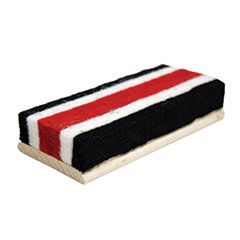
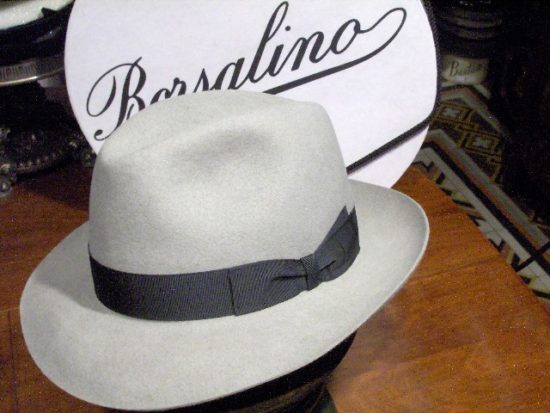

When I was in England a few years ago I came across a fascinating book on the felt industry there. The industry, like so many, is now pretty much gone. While some of the reasons the industry disappeared may be considered short-sighted it is certainly true that most industry has a finite life-span before something new — sometimes something wonderful — comes along and replaces it, changing the labour demographics and economies of towns and even nations. Plus ça change…n’est-ce que pas?
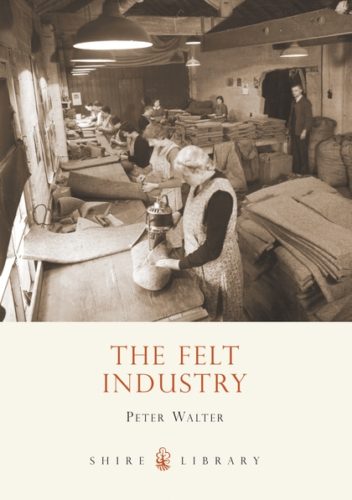
But wool felt has experienced a recent resurgence in the design and DIY fields. Beautiful furniture and household wares — including tea cosies, french press coffee cosies, mug warmers (!) — as well as fashion items are available and can be found through quick, easy internet searches. (Try duckduckgo.com for non-tracked searches.) For a great collection of contemporary wool felt pieces by designers and artists (ahem, including flockofteacosy.com) you might be interested in this Sydney Morning Herald piece from a few years ago.
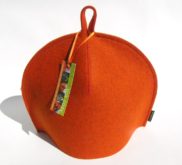
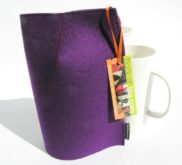

Flock of Tea Cosy’s shop.
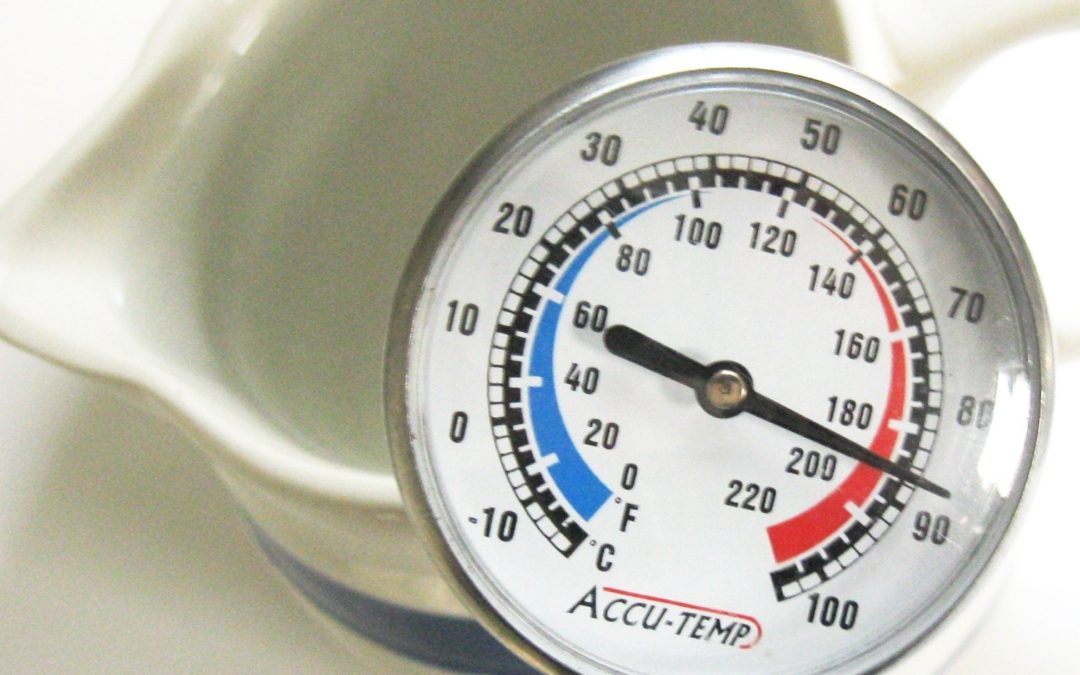
by Flock of Tea Cosy | Flock's Diary of modern wool felt teaware
Almost every tea culture does it — warms the teapot (or teacup) with the boiling water before making the tea in it. Why? Because the room-temperature vessel will steal almost ten degrees Celsius from the hot water. This means if you don’t pre-warm your teapot, your lovely tea loses that heat immediately. One of this flock of tea cosies will do an excellent job of keeping your pot of tea hot, but it can only maintain the heat that’s there.

As you can see, within about 20 seconds this room-temperature ceramic creamer stole over 10 degrees celcius heat from the boiling water just like a teapot does.

So warm that teapot first, then slip your tea cozy over it (say, isn’t that a smart modern tea cozy right there) — and you’ll have piping hot tea for ages.
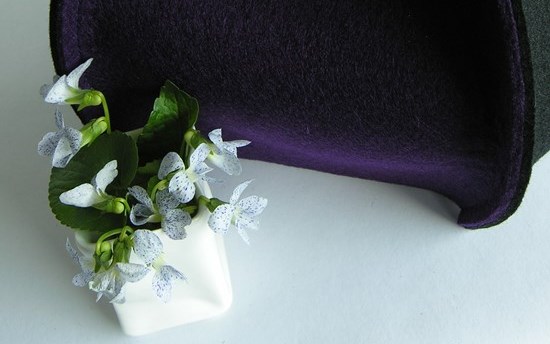
by Flock of Tea Cosy | Flock's Diary of modern wool felt teaware
Tea cozy hack and trivet test.
Customers are such an inventive lot. And helpful.
Fits a tall teapot too
Recently a customer ordered one of the flock’s cosies designed for a french press coffee maker, the 8-cup “Neu” design in Moss Green. Shortly after receiving it she wrote to tell me it fit her tall, narrow-proportioned teapot perfectly. A great customer cosy hack!
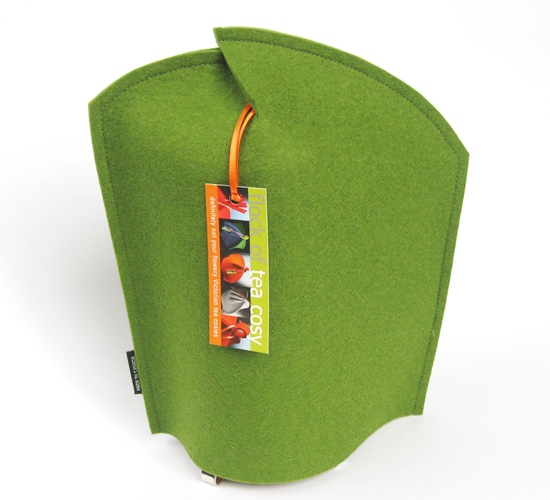
- “I love my green cozy. I have a tall teapot (I know it’s meant for a cafetierre) that I use every day and it fits perfectly!”
Trivets survive stove-hot espresso pot
I also recently received a query about whether the trivets could handle a hot-from-the-stove espresso pot. The colourful wool felt is wonderfully resilient, and perfect for protecting tabletops from hot teapots but I wasn’t confident enough to absolutely guarantee they’d hold up to stove-hot. It turns out they hold up just fine. On the flock’s behalf the customer put the trivet through its paces with her espresso pot and it came through with flying colours. No burn marks and no table-top harmed in the testing.

- “Ta dah! And worked out perfectly. No burn marks.”
Small tea cosy works as egg cosy
I mentioned this awhile ago but it’s worth mentioning again. A clever customer reported that the small tea cosies work wonderfully at keeping a bowl of soft boiled eggs hot on a Sunday morning. Another great tea cozy hack.
- “My wife and I are excited about the two new members of our tea family. They double as egg cozies as we soft boil several eggs and put them in a bowl.”

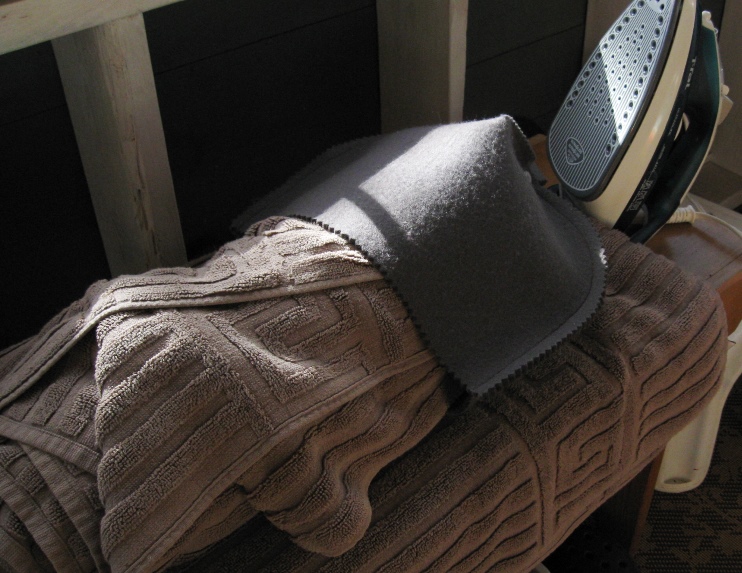
by Flock of Tea Cosy | Flock's Diary of modern wool felt teaware
Just back from a few days north of the city — still some spectacular colour clinging to the trees!
I was visiting SK, the friend to whom I’d given the very first tea cosy cut to what’s become the flock’s signature pattern — that rounded, Roman-helmet shape with a chatter of zig zag pinking along its edges.

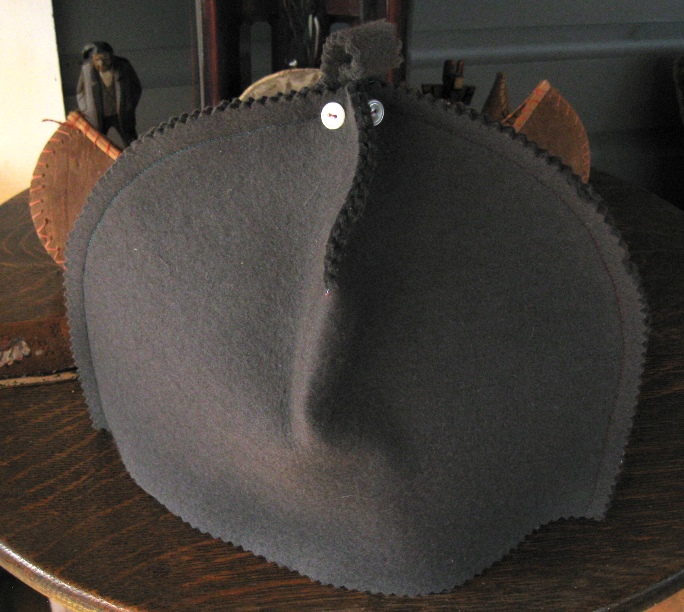
The cosy then and now. Not bad but life’s added a few creases and folds.
In the five years since it was made the cosy has experienced normal wear and tear and stuffing-in-drawers between tea-drinking visitors so, having a lazy afternoon at hand, I thought I’d see what kind of ‘spa’ rejuvenation I could render on it.

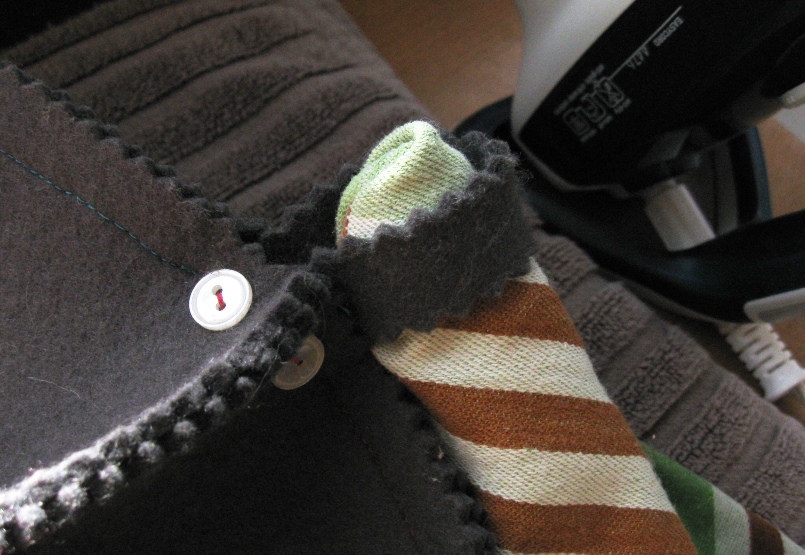
MacGyvoring a rolled thick bath towel to substitute for a small sleeve-ironing board, I placed a clean wet tea-towel between the felt tea cosy and the medium-hot (on medium steam setting) iron and gently and quickly ironed over the creases on both sides. Then rolled the tea towel to insert in the wonky top tab so it wouldn’t create a crease while I, again putting a clean wet tea towel between it and the iron, gave it a quick pass or two.
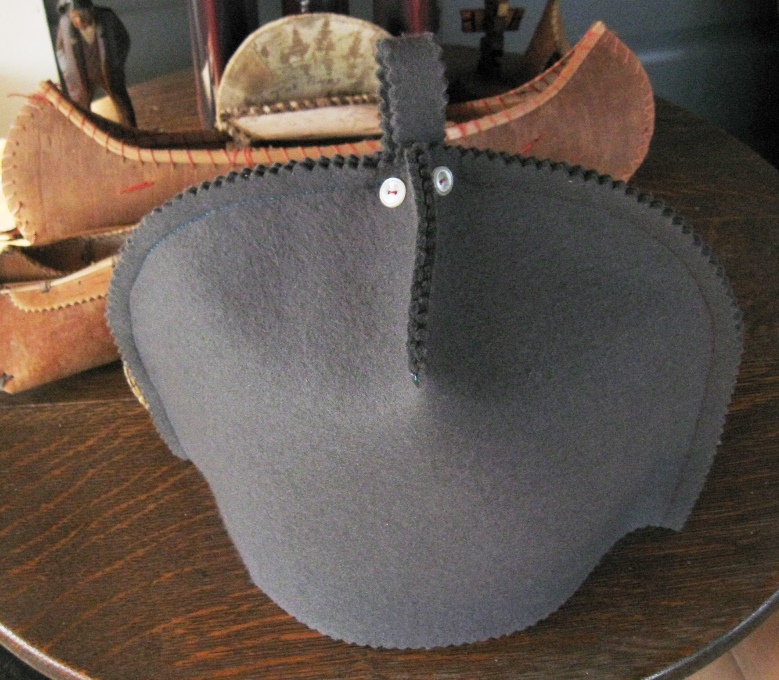
Et voila — pleased to report that a little steam ironing with a wet tea-towel between the felt and the medium-hot iron worked wonders. Just like it’d spent a day at the spa.

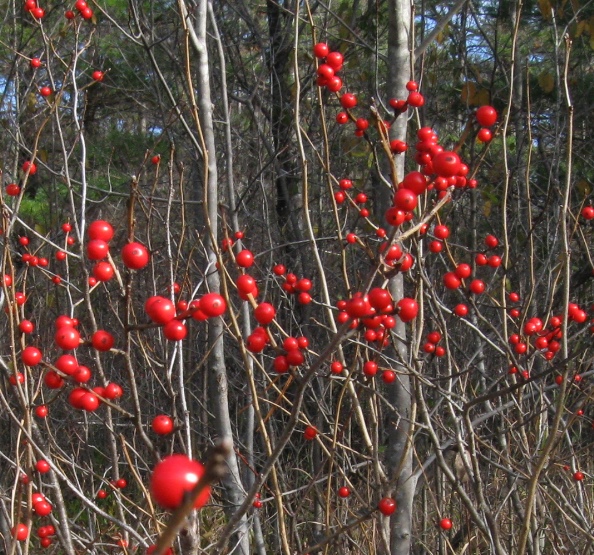
The marshes and streams were bursting with beautiful bright red berries. I don’t know what they are but I brought home an armload for the dining table.
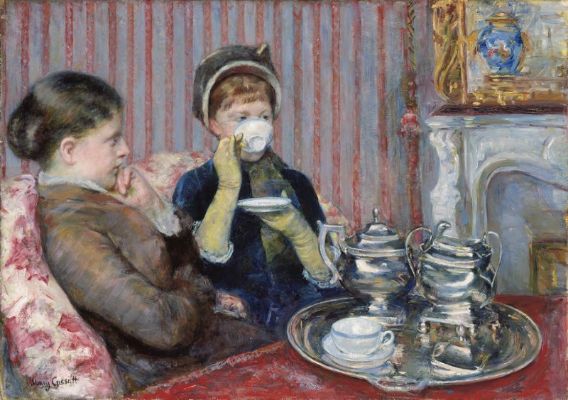
by Flock of Tea Cosy | Flock's Diary of modern wool felt teaware
I’m a big fan of Bill Bryson. For the past several years, since I discovered his writings, I’ve made a point of taking one of his books on my vacation. It ensures I will fall off my deck chair in stitches at least once.
I recently read his “At Home” which is a combination of history, humour and floor plans. Here’s a great quote for all us tea lovers:

“Between 1699 and 1721, tea imports increased almost a hundredfold, from 13,000 pounds to 1.2 million pounds, then quadrupled again the thirty years to 1750 …(but) Not everyone got the hang of tea immediately. The poet Robert Southey related the story of a lady in the country who received a pound of tea as a gift from a city friend when it was still a novelty. Uncertain how to engage with it, she boiled it up in a pot, spread the leaves on toast with butter and salt, and served it to her friends, who nibbled it gamely and declared it interesting but not quite to their taste. Elsewhere, however, it raced ahead, in tandem with sugar.”
And you know, tea on toast? Perhaps just ahead of her time.

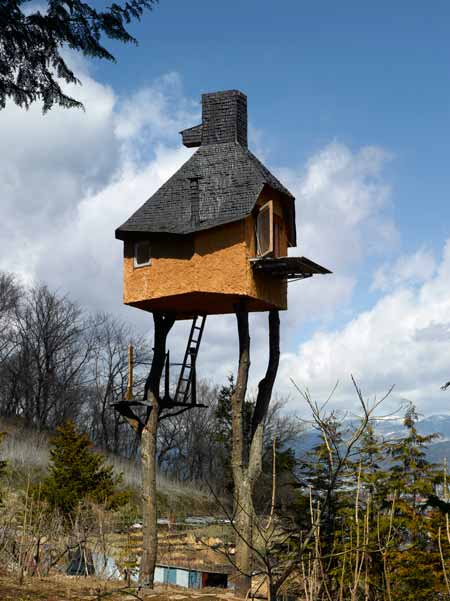
by Flock of Tea Cosy | Flock's Diary of modern wool felt teaware
Have you seen these? Perhaps it’s the spring in my garden — the sweet warm air, the fresh almost rubbery flowery buds, the crazily chirping birds — but my mind has been turning to garden structures and what more appropriate for this flock than a modern tea house?

A tea house by Terunobu Fujimori

The Black Tea House By David Maštálka of A1 Architects with sculptor Vojtech Bilisic — with exquisite detailing.

The Hat Tea House, also by A1 Architects
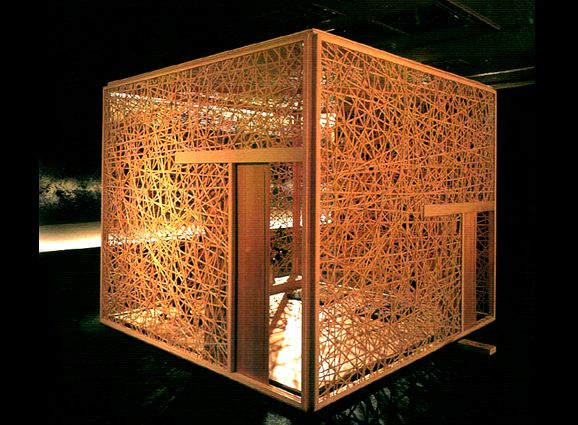
A pre-fab tea house kit from Tokyo Toshi (Note: sadly, the links I had to see more no longer work).

Actually designed by Saunders Architecture (photo by Iwan Baan) as an artist’s studio for Fogo Island, but a cup of tea would taste delicious in here I think.
I’d happily take any one of these, you?
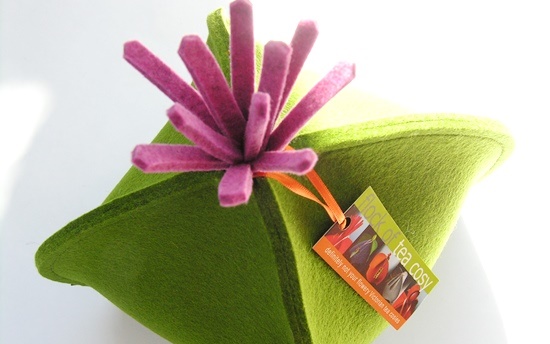
by Flock of Tea Cosy | Flock's Diary of modern wool felt teaware
I’m very proud of the craftsmanship and quality of the products I make to sell under the Flock of Tea Cosy banner, and it makes my day when a sale or a query comes over the transom, especially from some place faraway.
CLEAN, MODERN DESIGN
Some place like Finland, or Australia, or Italy, or the far west coast of the USA or even South Africa. It’s been the magic of the internet that enables the flock’s wares to be found by the relatively small, but, might I cheekily say, discerning, global group that appreciates these simple, cleanly designed, enduringly modern tea- and coffee-cosies.
WOOL FELT IS AN EXCELLENT INSULATOR
While most clients have mentioned it is the clean, minimalist design that brought them here, many have reported back their appreciation for this tableware being really good at its job. This is firstly due to the choice of fabric, dense wool felt, which is an excellent insulator. And secondly, because the Flock of Tea Cosy’s tea, coffee and mug cosy designs prevent heat from escaping which ensures the tea or coffee or hot chocolate stays hot.
A NATURAL FABRIC
Some clients have mentioned they were drawn to the natural fabric — wool felt is a natural fibre fabric (baa-baa sheep) which means it will a) decompose when its life is over, and b) is a renewable resource (ie: the sheep survive and are sheared every spring). It will leave a minimal footprint and is therefore eco-friendly.
CONSIDERED PRODUCTION
On that note, the Puzzle Pieces (trivets, coasters, mousepads, etc made from the off-cuts) use green-thinking to reduce the waste from the cosy production. More eco-friendly products using wool felt’s natural insulating quality.
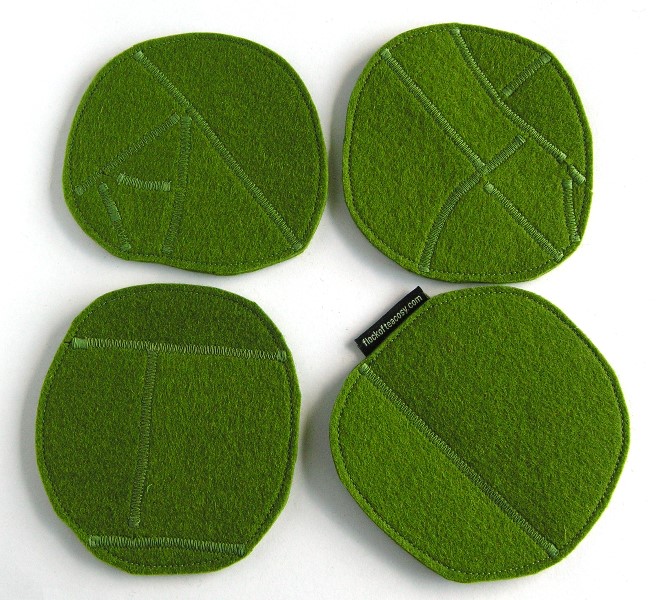
WELL MADE FROM QUALITY MATERIAL
Feedback also indicates notice of (thank you!) and appreciation for the excellent quality of the material used. The coloured 100% merino wool felt that Flock of Tea cosy uses is the best in the world. It’s made in western Europe to exacting and eco-concious standards. It is sturdy and consistent in its production, which can’t be said for some other sources, and the colours are rich and colour-fast. The Industrial wool felt, made here in North America, is a technical grade also made to top industry standards.
The high quality of the materials is paired with high standards of workmanship which ensure that each piece at Flock of Tea Cosy is well-made and made to last. Everything is individually handmade, all end seams are double-sewn, and the hang-tabs are securely hand-sewn on. For the puzzle-piece trivets, coasters and table-toppers all seams are button-hole stitched at their end.

With thanks to Flock of Tea Cosy’s clients, some first hand reports can be found here:
Testimonials

by Flock of Tea Cosy | Flock's Diary of modern wool felt teaware
It seems that if we’re tea drinkers then Sagittarius, the Archer is our man. Or rather, our constellation. Eight of Sagittarius’ brightest stars form a figure widely recognized by those who peer at the night sky as a teapot, with its handle to the left and its spout right, spewing steam in the form of Milky Way star clouds. How cool is that? (No tea cosy though, as far as I can see.)

The image is by New Zealand astrophotographer Christopher Picking.
Although we’re in the midst of the Sagittarius zodiacal sign (November 22 and December 21), as it happens it’s not the best time to observe the constellation nor the teapot.
Martin J. Powell explains: Sagittarius is best observed during the Northern hemisphere summer months (winter in the Southern hemisphere) because during this time the constellation is visible throughout the night and is seen in darkness when it is highest in the sky. Southern hemisphere observers have the best view of Sagittarius, since it crosses almost directly overhead in the sky. In general, the Northern hemisphere has a less favorable view – the visibility of the constellation being worse the further North one is situated. Indeed, the Southern section of the constellation cannot be seen at all from high Northern latitudes. Sagittarius is not visible all year round because, from the vantage point of the Earth in its orbit, the Sun is seen to pass through the constellation during the Northern hemisphere midwinter period (equivalent to the midsummer period in the Southern hemisphere).
So, fellow northerners, let’s make a late night, mid-summer date to sip tea and admire the heavens, shall we?


































